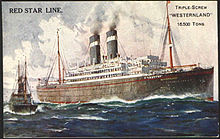|
Red Star Line
The Red Star Line was a shipping line founded in 1871 as a joint venture between the International Navigation Company of Philadelphia, which also ran the American Line, and the Société Anonyme de Navigation Belgo-Américaine of Antwerp, Belgium. The company's main ports of call were Antwerp[1][2] in Belgium, Liverpool and Southampton[1] in the United Kingdom and New York City[1] and Philadelphia[3] in the United States. HistoryThe principal American organizer and general agent of INC was the shipbroking firm of Peter Wright & Sons, a Philadelphia import-export house. The company had established friendships and business ties with two prominent Belgian shipowners, Jules-Bernard von Der Becke and William Edouard Marsily. During the 1860s, the von Der Becke firm became an important importer of petroleum products from Pennsylvania to Antwerp in American and Belgian ships.[4] Clement Griscom, who rose rapidly from clerk to partner at Peter Wright & Sons, was a leader in the firm's shipping affairs and the chief force behind the creation of both INN and the chief negotiator with Belgian's King Leopold, von Der Becke, and Marsily to establish a subsidiary company in Antwerp beginning on September 19, 1872, under the title "Societe Anonyme de Navigation Belge-Americaine" (Red Star Line). The agreement established the Red Star Line as the exclusive carrier of mail service out of Antwerp to Philadelphia and New York. This subsidiary would provide most of the company's profits for the next 30 years.[5] The shipping line's home port was Antwerp and it sailed under the Belgian flag, thereby avoiding the obligation of employing far more expensive American personnel.[6] Clement Griscom led the enterprise from its founding until the International Mercantile Marine Co. took it over in 1902. Red Star Line survived IMM's financial crisis in 1915. In the 1930s Red Star Line was part of Arnold Bernstein Line.[1] The company declared bankruptcy in 1934.[7] It operated until 1935 when it ceased trading. Its assets were eventually sold to the Holland America Line. Heritage The former warehouses of the Red Star Line in Antwerp were designated as a landmark and reopened as a museum on 28 September 2013 by the City of Antwerp.[8] The main focus of the museum is the travel stories that could be retrieved through relatives of the some two million Red Star Line passengers.[9][3] In the exhibition the visitor follows the travelers' tracks from the travel agency in Warsaw until their arrival in New York. The museum exhibits works of art depicting the Red Star Line emigrants by the Antwerp artist Eugeen Van Mieghem (1875-1930), together with Red Star Line memorabilia from the collection of Robert Vervoort.[8][10] About a quarter of the some two million Red Star Line migrants were Jews, largely from Eastern Europe until the exodus driven by the rise of Nazi Germany. Among them were many famous persons, including regular passenger Albert Einstein.[9][11] On learning of the Nazi confiscation of his possessions, Einstein chose not to return to Germany; his letter resigning from the Prussian Academy of Sciences, written on the line's stationery, is a part of the museum exhibit.[3] Other notable emigrants included the five-year-old Irving Berlin.[3] ShipsRed Star Line ships had a black funnel with a white band bearing a five-pointed red star.[1] The house flag was a white burgee with a red star.[1]  Most Red Star ships were given names ending in "-land". Notable Red Star ships included:


In popular cultureThe Red Star Lines appear in the Mario Puzo's The Godfather Part II when the young Vito Corleone arrives in New-York. His identification badge is from the Red Star Lines company. The Paris football club Red Star FC are named after the Red Star Line, on which the club's founder Jules Rimet's English housekeeper had travelled. In James Cameron's Titanic, a warehouse can be seen at the Southampton Docks labelled Red Star Line. It is seen through the window of the pub as Jack and Fabrizio are first introduced. ReferencesNotes
Bibliography
External linksWikimedia Commons has media related to Red Star Line.
|
||||||||||||||||
